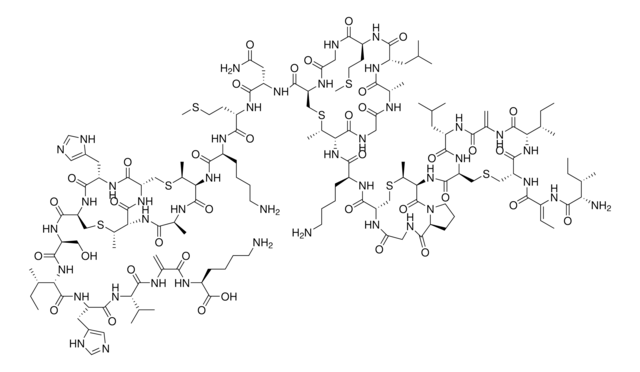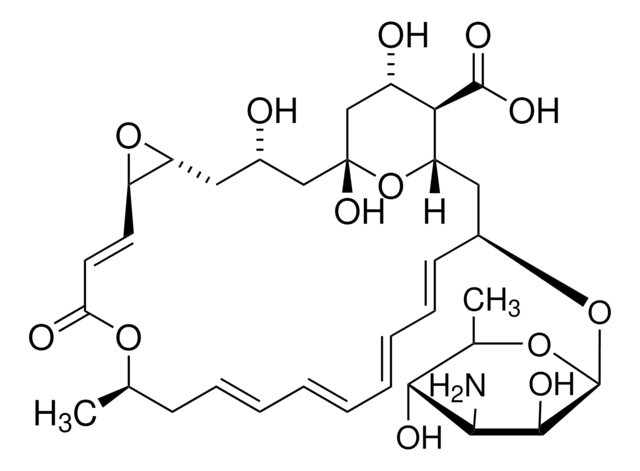N5764
Nisin from Lactococcus lactis
potency: ≥900 IU/mg
Sinonimo/i:
Nisin A
About This Item
Prodotti consigliati
Forma fisica
powder
Livello qualitativo
Potenza
≥900 IU/mg
Spettro attività antibiotica
Gram-negative bacteria
Gram-positive bacteria
Modalità d’azione
cell membrane | interferes
Temperatura di conservazione
2-8°C
Stringa SMILE
[H]N[C@@H]([C@@H](C)CC)C(=O)N\C(=C\C)C(=O)N[C@H]1CSC[C@H](NC(=O)[C@H](CC(C)C)NC(=O)C(=C)NC(=O)[C@@H](NC1=O)[C@@H](C)CC)C(=O)N[C@H]2[C@H](C)SC[C@H](NC(=O)CNC(=O)[C@@H]3CCCN3C2=O)C(=O)N[C@H](CCCCN)C(=O)N[C@@H]4[C@@H](C)SC[C@H](NC(=O)CNC(=O)[C@H](CCSC)NC(=O)[C@H](CC(C)C)NC(=O)[C@H](C)NC(=O)CNC4=O)C(=O)N[C@@H](CC(N)=O)C(=O)N[C@@H](CCSC)C(=O)N[C@@H](CCCCN)C(=O)N[C@H]5[C@H](C)SC[C@@H]6NC(=O)[C@@H](NC(=O)[C@H](C)NC5=O)[C@H](C)SC[C@H](NC(=O)[C@H](Cc7cnc[nH]7)NC6=O)C(=O)N[C@@H](CO)C(=O)N[C@@H]([C@@H](C)CC)C(=O)N[C@@H](Cc8cnc[nH]8)C(=O)N[C@@H](C(C)C)C(=O)NC(=C)C(=O)N[C@@H](CCCCN)C(O)=O
InChI
1S/C143H230N42O37S7/c1-24-69(11)105(148)135(213)162-82(27-4)118(196)174-94-58-225-59-95(175-123(201)89(48-67(7)8)169-115(193)74(16)158-138(216)107(70(12)25-2)180-132(94)210)133(211)184-112-79(21)229-61-96(160-104(190)56-152-134(212)100-38-34-44-185(100)142(112)220)128(206)164-84(36-29-32-42-145)120(198)182-109-76(18)226-60-97(161-103(189)55-151-117(195)85(39-45-223-22)165-122(200)88(47-66(5)6)168-113(191)72(14)156-102(188)54-153-136(109)214)129(207)171-92(51-101(147)187)125(203)166-86(40-46-224-23)119(197)163-83(35-28-31-41-144)121(199)183-110-77(19)228-63-99-130(208)170-90(49-80-52-149-64-154-80)124(202)176-98(62-227-78(20)111(141(219)177-99)181-116(194)75(17)159-140(110)218)131(209)173-93(57-186)127(205)179-108(71(13)26-3)139(217)172-91(50-81-53-150-65-155-81)126(204)178-106(68(9)10)137(215)157-73(15)114(192)167-87(143(221)222)37-30-33-43-146/h27,52-53,64-72,75-79,83-100,105-112,186H,15-16,24-26,28-51,54-63,144-146,148H2,1-14,17-23H3,(H2,147,187)(H,149,154)(H,150,155)(H,151,195)(H,152,212)(H,153,214)(H,156,188)(H,157,215)(H,158,216)(H,159,218)(H,160,190)(H,161,189)(H,162,213)(H,163,197)(H,164,206)(H,165,200)(H,166,203)(H,167,192)(H,168,191)(H,169,193)(H,170,208)(H,171,207)(H,172,217)(H,173,209)(H,174,196)(H,175,201)(H,176,202)(H,177,219)(H,178,204)(H,179,205)(H,180,210)(H,181,194)(H,182,198)(H,183,199)(H,184,211)(H,221,222)/b82-27+/t69-,70-,71-,72-,75-,76?,77?,78?,79?,83-,84+,85-,86-,87-,88-,89-,90-,91-,92-,93-,94-,95-,96-,97-,98-,99-,100-,105-,106-,107-,108-,109+,110-,111-,112-/m0/s1
NVNLLIYOARQCIX-ILAIHEEGSA-N
Cerchi prodotti simili? Visita Guida al confronto tra prodotti
Categorie correlate
Descrizione generale
Applicazioni
Azioni biochim/fisiol
Mode of Action: Binds to and interferes with the permeability of the cytoplasmic membrane.
Antimicrobial spectrum: Gram-negative and Gram-positive bacteria (requires chelator such as EDTA).
Confezionamento
Altre note
Codice della classe di stoccaggio
11 - Combustible Solids
Classe di pericolosità dell'acqua (WGK)
WGK 3
Punto d’infiammabilità (°F)
Not applicable
Punto d’infiammabilità (°C)
Not applicable
Dispositivi di protezione individuale
Eyeshields, Gloves, type N95 (US)
Certificati d'analisi (COA)
Cerca il Certificati d'analisi (COA) digitando il numero di lotto/batch corrispondente. I numeri di lotto o di batch sono stampati sull'etichetta dei prodotti dopo la parola ‘Lotto’ o ‘Batch’.
Possiedi già questo prodotto?
I documenti relativi ai prodotti acquistati recentemente sono disponibili nell’Archivio dei documenti.
I clienti hanno visto anche
Articoli
With bacterial resistance and emerging infectious diseases becoming potential threats to humans, ribosomally synthesized antimicrobial peptides have become a promising focus area in antibiotic research.
Il team dei nostri ricercatori vanta grande esperienza in tutte le aree della ricerca quali Life Science, scienza dei materiali, sintesi chimica, cromatografia, discipline analitiche, ecc..
Contatta l'Assistenza Tecnica.








